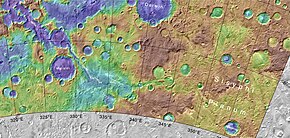 Topo map showing the location of Wegener Crater Topo map showing the location of Wegener Crater | |
| Planet | Mars |
|---|---|
| Region | Argyre quadrangle |
| Coordinates | 64°36′S 4°00′W / 64.6°S 4°W / -64.6; -4 |
| Quadrangle | Argyre |
| Diameter | 68.51 km (42.57 mi) |
| Eponym | Alfred Wegener |
Wegener is an impact crater in the Argyre quadrangle of Mars, located at 64.6°S latitude and 4.0°W longitude. It measures approximately 68.51 kilometres (42.57 mi) in diameter and was named after German geophysicist Alfred Wegener (1880–1930). The name was approved by IAU's Working Group for Planetary System Nomenclature in 1973.
Description


Dark spots appear on dunes in the higher latitudes of Mars. In these spots mineral grains may be covered with a thin film of water that may affect chemical weathering of minerals and may help possible Martian organisms to survive. Studies have shown that thin films of water could exist at times on the Martian surface at certain times and in certain locations. In places, thin layers of liquid water could be present for 38 sols (Martian days) in the warmer periods of the day. Dark spots appear on dunes in the higher latitudes of Mars.
Sometimes geysers form near the spots. They have two main features (dark dune spots and spider channels) that appear at the beginning of the Martian spring on dune fields covered with carbon dioxide (CO2 or 'dry ice'), mainly at the ridges and slopes of the dunes; by the beginning of winter, they disappear. Dark spots' shape is generally round, on the slopes it is usually elongated.
With the stronger sunshine of spring in certain regions, carbon dioxide gas jets shoot dark dust in the air. This dark dust will increase the absorption of light and cause the temperature to rise to where water can exist for short periods.
See also
References
- "Gazetteer of Planetary Nomenclature | Wegener". usgs.gov. International Astronomical Union. Retrieved 4 March 2015.
- Zent, A.P., Haberle, R.M., Howard, C.H., Jakosky, B.M., 1993. "A coupled subsurface boundary layer model of water on Mars". J. Geophys. Res. 98, 3319–3337.
- Mohlmann, D., 2004. "Water in the upper martian surface at mid- and low-latitudes: Presence, state, and consequences". Icarus 168, 318–323.
- Horváth, A.; Kereszturi, Á.; Bérczi, Sz.; et al. (2005). "Annual change of Martian DDS-seepages" (PDF). Lunar and Planetary Science XXXVI: 1128. Bibcode:2005LPI....36.1128H. Retrieved 24 November 2008.
- Gánti, Tibor; András Horváth; Szaniszló Bérczi; Albert Gesztesi; Eörs Szathmáry (12–16 March 2001). Probable Evidences of Recent Biological Activity on Mars: Appearance and Growing of Dark Dune Spots in the South Polar Region (PDF). 32nd Annual Lunar and Planetary Science Conference. Houston, Texas. Retrieved 20 November 2008.
- Kereszturi, A., E. Rivera-Valentin. 2012. "Locations of thin liquid water layers on present-day Mars". Icarus: 221, 289–295.